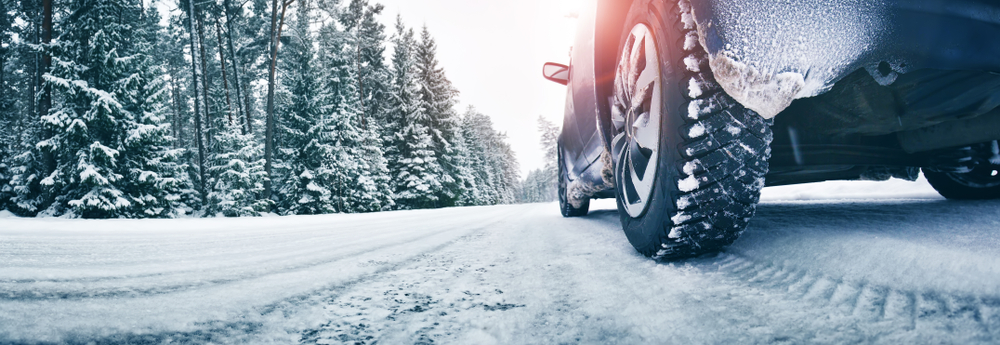Here are a few tips:
Schedule a tune-up
If your vehicle is due for a tune-up make sure to schedule it during the fall. Cold weather increases existing problems like hard starts, sluggish performance, pings, and rough idling. Go through the owner's manual for the tune-up schedule and stick to it.
Switch to winter tires
Driving in winter means exercising great caution - there are high chances of facing heavy snowfall or black ice on the roads! The weather can change in a jiffy, which ordinary tires can't withstand. All-season tires during this time are no good because their tread compound hardens when temperatures fall, which reduces the traction between the roads and tires. Snow tires are manufactured to tolerate and operate in cold temperatures and harsh weather. Advanced rubber compounds are used in winter tires that retain pliability in the cold, thereby imparting a solid grip and better braking in extreme conditions.
Tread designs of winter tires are incorporated to fight against ice, snow and other severe winter conditions. This prevents the vehicle from skidding. The more aggressive the tread, the more it reduces snow build up on the tires. These tires perform well in all types of winter conditions - snow, ice, sleet, slush, wet and even cold dry roads.
Ensure the heat and defroster is still working
You shouldn't start getting your car ready for winter on the day temperatures plummet below freezing and you realize the heater isn't working. Be sure to check the heater and defroster in the fall to determine if they are functioning properly. If not, get them fixed immediately.
Replace windshield wiper blades
Wiper blades should be replaced every six months. If the ones on your car are leaving patches on the windshield, replace them before the cold weather causes the rubber to stiffen up more.
You might consider switching to winter wiper blades as well since the ordinary ones get packed with snow and cause the blades to streak or miss large portions of the windshield. Winter wiper blades come with a rubber casing enclosing the whole blade, thus preventing ice and snow from sticking or packing. Your visibility is better and winter driving is much safer. Remove and store old wiper blades for next spring.
Change fluids
Before the chilly winter temperatures set in, you need to take care of the fluids in your vehicle. Brake system fluid, coolant, transmission fluid, power steering fluid, washer fluid, and suspension differential fluid should be changed.
Brake fluids often get contaminated due to sediment and other impurities, so a routine change could be a good idea. Some manufacturers suggest you change transmission fluid when the car logs 100,000 miles. But it is best to ask your mechanic depending upon the age and wear of the vehicle. Use cold weather washer fluid in the winter, and keep the reservoir full. Keep a bottle in the trunk as it comes in handy when grimy snow or road salt smears your windshield.
Check brakes
Brakes are responsible for your safety when you drive. Before they are put to the test due to ice and snow on the roads, it is imperative to get brakes and brake fluid inspected. If required, replace the brake pads so you don't face trouble while stopping on slippery roads. Get the emergency brake checked too. Even if the brake pads are in good condition, cables or mechanical components can seize or break, especially if they are unused.
Don't forget tire pressure
Tires have to be correctly inflated to guarantee best possible traction as you drive in adverse weather. However, this aspect is often immensely jeopardized due to wet, snowy, or icy roads. The air pressure in your tires has likely dropped as the weather has gotten colder, so it is crucial to get it checked. Do consult your owner's manual to find out what your target tire pressure should be.
Clean and check car battery
Cold weather can be tough on batteries. You should get the battery and charging system inspected for optimum performance every fall. This is all the more vital as many computerized safety systems in cars run off battery power. The battery should be cleaned thoroughly as well. Check for residue on battery posts and remove it with a wire brush. Wipe down the battery case to get rid of grease and grime.
Test headlights and taillights
Winter means shorter days and longer nights, so it gets dark quicker than usual and your vehicle lights have to be in excellent condition. Get the car's headlights and taillights checked to ensure if they are working and correctly aimed. If headlights seem to be less powerful than they used to be, clean them. You might have to replace them if they seem dimmer than usual or aren't functioning at all.
Keep the gas tank full
When winter comes, keep the gas tank at least half full at all times to reduce the chance of moisture forming in the gas lines and possibly freezing. Plus, you never know when a sudden snow squall will stretch your commute to hours on the road. This way you don't have to worry about running out of gas as you try to get home safely.
Last but not the least...
Getting your car ready for winter means being prepared for all kinds of situations such as getting stranded for few hours due to a storm! An emergency kit is a must-have, and it needs to contain an ice scraper and snow brush, jumper cables, flashlight, flares, blanket, extra warm clothes (including gloves and hat), candles/matches, bottled water, dry food snacks and medications.
If you are looking for websites to sell cars, then WorldCarHub.com is a fabulous platform to stay informed about the latest makes and models in the market.

